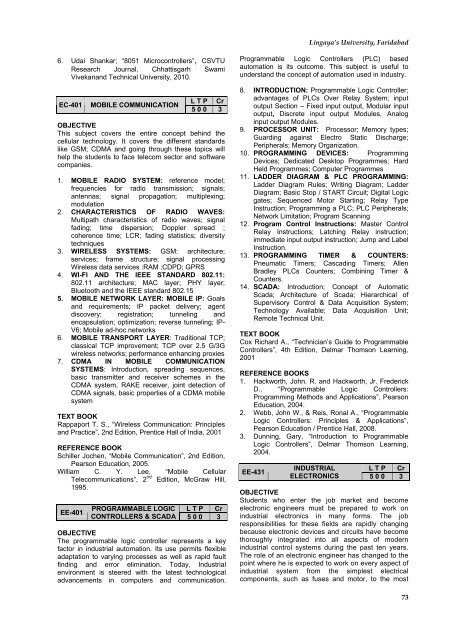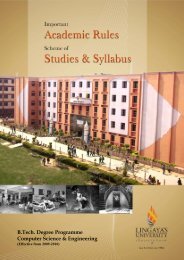B.<strong>Tech</strong>. <strong>Electrical</strong> <strong>Engineering</strong> (Regular)CS-422CRYPTOGRAPHY AND L T P CrDATA COMPRESSION 5 0 0 3EC-305 EMBEDDED SYSTEM DESIGNL T P Cr5 0 0 3OBJECTIVEThe course will attempt to dispel some of the manymyths that surround the idea of cryptography.Cryptography is (and will continue to be) anincreasingly important area of IT and it is important thatpractitioners are aware of the realities of the subject.The course will provide a down-to-earth overview ofcryptographic techniques applicable in an ITenvironment, and outline the constraints and limitationsof realistic secure systems. A running theme is thetradeoff between usability and security of a system.Also covered are a number of compression techniques- data compression and data encryption are, in somerespects, closely related. A working knowledge of C isassumed and essential.PRE-REQUISITESKnowledge of cryptography, analysis & designalgorithms and mathematics1. INTRODUCTION: Basics of cryptography; history;usefulness of compression techniques2. COMPRESSION: Packing, Huffman coding, Runlength encoding, Lempel-Ziv-Welch, PKZIP, Deltamodulation, JPEG; latest compression techniques3. ERROR DETECTION AND CORRECTION: Parity,1, 2, n-dimensions, Hamming codes, p-out-of-qcodes4. CRYPTOGRAPHY: vocabulary; history;steganography - visual textual, cipher hiding, falseerrors; public key cryptography – authentication;signatures; deniability5. MATHEMATICS: information; confusion; diffusion;modular arithmetic; inverses; Fermats littletheorem; Chinese remainder theorem, factoring;prime numbers; discrete logarithms6. ALGORITHMS: DES, AES (Rijndael), IDEA, Onetime pad, Secret sharing and splitting, RSA, Ellipticcurves, Modes, Random numbers7. ATTACKING SYSTEMS: Recognition, Destroyingdata, Cryptanalysis - Differential cryptanalysis -cracking DESTEXT BOOKB. Schneier, “Applied Cryptography: Protocols,Algorithms and Source Code in C”, 2nd edition, Wiley,1996.REFERENCE BOOKS1. Suhas Desai, “Security in Computing”, PearsonEducation, 20102. “Integration of Data Compression andCryptography: Another Way to Increase theInformation Security”, IEEE Computer SocietyVolume 2, 20073. W. Trappe and L. Washington, “Introduction toCryptography”, 2nd edition, Pearson Education, 2006WEB REFERENCES1. http://www.data-compression.com/index.shtml2. http://www.webopedia.com/TERM/D/data_compression.html3. http://en.wikipedia.org/wiki/Data_compression4. http://www.debugmode.com/imagecmp/OBJECTIVEThe course intends to cover the design issues involvedin embedded systems and system-on-chip technologies.The course also deals with the applications andprogramming languages and processor architecturesused for embedded systems. This course introduces thestudents to standard Embedded System Developmenttools and gives a hands-on experience in developingvarious embedded applications.1. INTRODUCTION: Different types ofmicrocontrollers: Embedded microcontrollers;External memory microcontrollers; ProcessorArchitectures: Harvard V/S Princeton; CISC V/SRISC; microcontrollers memory types; Introductionto Real Time Operating System.2. 8051 MICROCONTROLLER ARCHITECTURE:Architecture; memory considerations; Addressingmodes; clocking; i/o pins; interrupts; timers;peripherals; serial communication; Instruction set;simple operations.3. PIC MICROCONTROLLER ARCHITECTURE:Introduction to PIC microcontrollers; Architectureand pipelining; program memory considerations;Addressing modes; CPU registers; Instruction set;simple operations.4. INTERRUPTS AND I/O PORTS: Interrupt logic;Timer2 scalar initialization; IntService Interruptservice routine; loop time subroutine; Externalinterrupts and timers; synchronous serial portmodule; serial peripheral device; O/p portExpansion; I/p port expansion; UART.5. SOFTWARE: Development tools/ environments;Assembly language programming style;Interpreters; High level languages; Intel hex formatobject files; Debugging.6. PROGRAMMING WITH MICRO-CONTROLLERS: Arithmetic operations; Bitaddressing; Loop control; Stack operation;Subroutines; interfacing of 8051 with LCD; LED;keyboard; motors; seven segment and otherinterfacing; PIC simple operations.7. DESIGNING USING MICROCONTROLLERS:Music box; Mouse wheel turning; PWM motorcontrol; aircraft demonstration; ultra sonic distancemeasuring; temperature sensor; pressure sensor;magnetic field sensor.TEXT BOOKJohn B. Peatman, “Design with PIC Microcontrollers”,Pearson Education, 4th edition, 2005.REFERENCE BOOKS1. Mazidi, “8051 Microcontroller”, 2nd Edition,Prentice Hall, 20052. Predko, “Programming and Customizing the 8051Microcontroller”, 2nd Edition, McGraw Hill, 2002.3. Catsoulis John, “Designing Embedded Hardware”,2 nd Edition, O’Media, 2005.4. Barr Michael, “Programming Embedded Systems inC and C++”, Shroff Pub. and Distr., 3rd Edition, 2003.5. Ayala A. J., “The 8051 Microcontroller:Architecture, Programming, and Applications”,Pap/Dsk edition, West Publishing Company, 199172
Lingaya’s University, Faridabad6. Udai Shankar; “8051 Microcontrollers”, CSVTUResearch Journal, Chhattisgarh SwamiVivekanand <strong>Tech</strong>nical University, 2010.EC-401MOBILE COMMUNICATIONL T P Cr5 0 0 3OBJECTIVEThis subject covers the entire concept behind thecellular technology. It covers the different standardslike GSM; CDMA and going through these topics willhelp the students to face telecom sector and softwarecompanies.1. MOBILE RADIO SYSTEM: reference model;frequencies for radio transmission; signals;antennas; signal propagation; multiplexing;modulation2. CHARACTERISTICS OF RADIO WAVES:Multipath characteristics of radio waves; signalfading; time dispersion; Doppler spread ;coherence time; LCR; fading statistics; diversitytechniques3. WIRELESS SYSTEMS: GSM: architecture;services; frame structure; signal processingWireless data services :RAM ;CDPD; GPRS4. WI-FI AND THE IEEE STANDARD 802.11:802.11 architecture; MAC layer; PHY layer;Bluetooth and the IEEE standard 802.155. MOBILE NETWORK LAYER: MOBILE IP: Goalsand requirements; IP packet delivery; agentdiscovery; registration; tunneling andencapsulation; optimization; reverse tunneling; IP-V6; Mobile ad-hoc networks6. MOBILE TRANSPORT LAYER: Traditional TCP;classical TCP improvement; TCP over 2.5 G/3Gwireless networks; performance enhancing proxies7. CDMA IN MOBILE COMMUNICATIONSYSTEMS: Introduction, spreading sequences,basic transmitter and receiver schemes in theCDMA system, RAKE receiver, joint detection ofCDMA signals, basic properties of a CDMA mobilesystemTEXT BOOKRappaport T. S., “Wireless Communication: Principlesand Practice”, 2nd Edition, Prentice Hall of India, 2001REFERENCE BOOKSchiller Jochen, “Mobile Communication”, 2nd Edition,Pearson Education, 2005.William C. Y. Lee, “Mobile CellularTelecommunications”, 2 nd Edition, McGraw Hill,1995.EE-401PROGRAMMABLE LOGIC L T P CrCONTROLLERS & SCADA 5 0 0 3OBJECTIVEThe programmable logic controller represents a keyfactor in industrial automation. Its use permits flexibleadaptation to varying processes as well as rapid faultfinding and error elimination. Today, Industrialenvironment is steered with the latest technologicaladvancements in computers and communication.Programmable Logic Controllers (PLC) basedautomation is its outcome. This subject is useful tounderstand the concept of automation used in industry.8. INTRODUCTION: Programmable Logic Controller;advantages of PLCs Over Relay System; inputoutput Section – Fixed input output, Modular inputoutput, Discrete input output Modules, Analoginput output Modules.9. PROCESSOR UNIT: Processor; Memory types;Guarding against Electro Static Discharge;Peripherals; Memory Organization.10. PROGRAMMING DEVICES: ProgrammingDevices; Dedicated Desktop <strong>Programme</strong>s; HardHeld <strong>Programme</strong>s; Computer <strong>Programme</strong>s11. LADDER DIAGRAM & PLC PROGRAMMING:Ladder Diagram Rules; Writing Diagram; LadderDiagram; Basic Stop / START Circuit; Digital Logicgates; Sequenced Motor Starting; Relay TypeInstruction; Programming a PLC; PLC Peripherals;Network Limitation; Program Scanning12. Program Control Instructions: Master ControlRelay Instructions; Latching Relay instruction;immediate input output instruction; Jump and LabelInstruction.13. PROGRAMMING TIMER & COUNTERS:Pneumatic Timers; Cascading Timers; AllenBradley PLCs Counters; Combining Timer &Counters.14. SCADA: Introduction; Concept of AutomaticScada; Architecture of Scada; Hierarchical ofSupervisory Control & Data Acquisition System;<strong>Tech</strong>nology Available; Data Acquisition Unit;Remote <strong>Tech</strong>nical Unit.TEXT BOOKCox Richard A., “<strong>Tech</strong>nician’s Guide to ProgrammableControllers”, 4th Edition, Delmar Thomson Learning,2001REFERENCE BOOKS1. Hackworth, John. R. and Hackworth, Jr. FrederickD., “Programmable Logic Controllers:Programming Methods and Applications”, PearsonEducation, 2004.2. Webb, John W., & Reis, Ronal A., “ProgrammableLogic Controllers: Principles & Applications”,Pearson Education / Prentice Hall, 2008.3. Dunning, Gary, “Introduction to ProgrammableLogic Controllers”, Delmar Thomson Learning,2004.EE-431INDUSTRIAL L T P CrELECTRONICS 5 0 0 3OBJECTIVEStudents who enter the job market and becomeelectronic engineers must be prepared to work onindustrial electronics in many forms. The jobresponsibilities for these fields are rapidly changingbecause electronic devices and circuits have becomethoroughly integrated into all aspects of modernindustrial control systems during the past ten years.The role of an electronic engineer has changed to thepoint where he is expected to work on every aspect ofindustrial system from the simplest electricalcomponents, such as fuses and motor, to the most73
- Page 1 and 2:
B.Tech. Degree ProgrammeElectrical
- Page 5 and 6:
Lingaya’s University, FaridabadAB
- Page 7 and 8:
IMPORTANT ACADEMIC RULESB.Tech. Deg
- Page 9 and 10:
Lingaya’s University, Faridabadac
- Page 11 and 12:
Lingaya’s University, FaridabadSe
- Page 13 and 14:
Lingaya’s University, FaridabadIn
- Page 15 and 16:
CATEGORY-WISE LIST OF COURSESLingay
- Page 17 and 18:
Lingaya’s University, FaridabadSU
- Page 19 and 20:
Lingaya’s University, FaridabadSc
- Page 22 and 23:
B.Tech. Electrical Engineering (Reg
- Page 24 and 25:
B.Tech. Electrical Engineering (Reg
- Page 26 and 27: B.Tech. Electrical Engineering (Reg
- Page 28 and 29: B.Tech. Electrical Engineering (Reg
- Page 30 and 31: B.Tech. Electrical Engineering (Reg
- Page 32 and 33: B.Tech. Electrical Engineering (Reg
- Page 34 and 35: B.Tech. Electrical Engineering (Reg
- Page 36 and 37: B.Tech. Electrical Engineering (Reg
- Page 38 and 39: B.Tech. Electrical Engineering (Reg
- Page 40 and 41: B.Tech. Electrical Engineering (Reg
- Page 42 and 43: B.Tech. Electrical Engineering (Reg
- Page 44 and 45: B.Tech. Electrical Engineering (Reg
- Page 46 and 47: B.Tech. Electrical Engineering (Reg
- Page 48 and 49: B.Tech. Electrical Engineering (Reg
- Page 50 and 51: B.Tech. Electrical Engineering (Reg
- Page 52 and 53: B.Tech. Electrical Engineering (Reg
- Page 54 and 55: B.Tech. Electrical Engineering (Reg
- Page 56 and 57: B.Tech. Electrical Engineering (Reg
- Page 58 and 59: B.Tech. Electrical Engineering (Reg
- Page 60 and 61: B.Tech. Electrical Engineering (Reg
- Page 62 and 63: B.Tech. Electrical Engineering (Reg
- Page 64 and 65: B.Tech. Electrical Engineering (Reg
- Page 66 and 67: B.Tech. Electrical Engineering (Reg
- Page 68 and 69: B.Tech. Electrical Engineering (Reg
- Page 71 and 72: OPEN ELECTIVELingaya’s University
- Page 73 and 74: Lingaya’s University, Faridabadch
- Page 75: Lingaya’s University, Faridabad4
- Page 79 and 80: Lingaya’s University, FaridabadEL
- Page 81 and 82: Lingaya’s University, Faridabad5
- Page 83 and 84: Lingaya’s University, Faridabador
- Page 85 and 86: Lingaya’s University, Faridabad4.
- Page 87: Lingaya’s University, Faridabad83
















